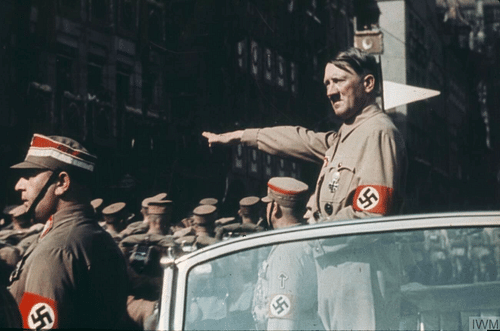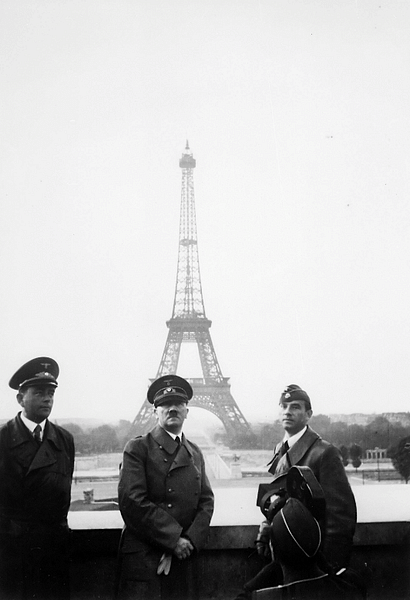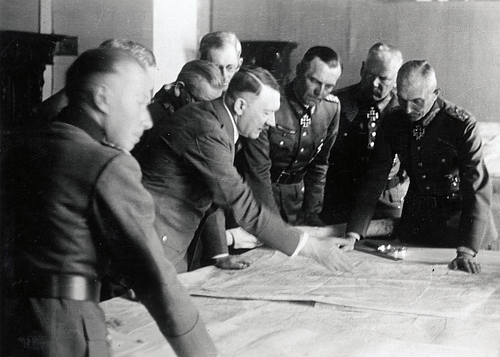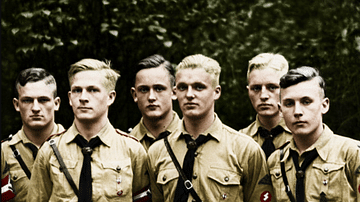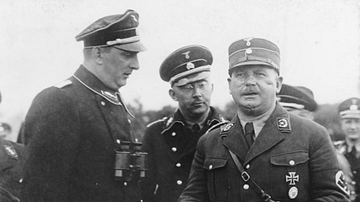
Adolf Hitler (1889-1945) was the dictator of Nazi Germany from 1933. He gained power by making popular promises like improving Germany's economy and status in Europe, but when he took these policies too far, he was responsible more than anything else for starting the Second World War (1939-45). Germany lost the war, and Hitler committed suicide in April 1945.
Early Life
Adolf Hitler was born on 20 April 1889 in the Austrian village of Braunau am Inn. His father was Alois Schicklgruber (although there is some speculation about this), who changed the family name to Hitler. Alois earned a living as a cobbler before progressing to become an assistant customs inspector. Adolf's mother was Klara Pölzl, Alois' third wife. Alois was a domineering father, who beat Adolf when he was guilty of some wrongdoing while Klara doted on her son. Alois died in 1903, and thereafter, Adolf neglected his studies – most of his time was spent reading history and western novels or "moping around the house with delusions of becoming an artist or architect" (Boatner, 223). The family moved to Linz in 1905. Adolf visited Vienna the next year and then, in 1907, he attempted to enter that city's Academy of Fine Arts but failed the exam. After again failing the Academy exam in 1908, Adolf instead tried the School for Architecture but found his lack of qualifications blocked him here, too.
Following his mother's death in December 1907, Hitler spent the next five years in Vienna making few friends and little money by painting posters and postcards. Fortunately, he had a small income from a family legacy to supplement his meagre work. Speculation about Hitler's health in this period include him catching syphilis and suffering from impotence. More significantly for his future, "Hitler's political awakening came in Vienna. He admired the city's anti-Semitic and nationalist mayor Karl Lueger and learned the potential of propaganda and the management of mass movements" (Boatner, 223). In 1913, seeking to avoid compulsory military service in Austria, Hitler moved to Germany, taking up residence in Munich.
When the First World War (1914-18) began, Hitler, now feeling it a patriotic duty, enlisted in the Bavarian army. Serving as a messenger in France, Hitler impressed his superiors and was awarded the Iron Cross Second Class medal. He was badly wounded in the thigh by a piece of shrapnel in the Battle of the Somme but returned to fight in 1917. He reached the rank of lance corporal but no higher since his superiors "could discover no leadership qualities in him" (McDonough 2012, 34). He did win the Iron Cross First Class but was again hospitalised, this time by a gas attack. Despite feeling betrayed by the 1918 armistice, Hitler stayed in the army and became an instructor in Munich, mostly lecturing on the dangers of communism. He would soon decide to take more practical steps to reshape Germany and set it free from its enemies.
The Nazi Party
The fascist National Socialist German Workers' Party (NSDAP or Nazi Party for short) was founded in 1920 as the German Workers Party. It was Hitler who extended the name. The party was neither socialist nor at all interested in workers, but the new name gave this ultra-nationalist party as wide an appeal as possible. Hitler, thanks to his gift for public speaking, became leader of the party in 1921, taking over from Anton Drexler (1884-1942).
Hitler had big ambitions, and so he attempted to seize power in November 1923. The attempted coup, known as the Beer Hall Putsch because it began in a beer hall, terminated in Hitler's arrest. The coup had failed because other right-wing politicians, the police, and the army did not give the Nazis their support. Put on trial for treason and found guilty, Hitler was imprisoned. The publicity of the trial and Hitler's oratory skills in court did no harm at all to the Nazis' popularity. Hitler's incarceration only lasted a year, and he used the time to write a book, Mein Kampf ('My Struggle'), which set out his thoughts on statecraft and how he would change Germany if he were its leader.
Character & Relationships
In 1925, Hitler rented a villa near Berchtesgaden in Bavaria, which he later bought, extended, and called the Berghof. Hitler said that he spent "the finest hours of my life" (Boatner, 224) in this mountain retreat. He lived at the Berghof with a widowed half-sister and her two daughters. There were suspicions that Hitler and one of the daughters, Geli, had a love affair, but the domestic staff denied this was ever the case. Geli committed suicide in September 1931, and Hitler was devastated, insisting her room at the Berghof remain forever as it was on the day she died.
In 1932, Hitler started a life-long relationship with Eva Braun (1912-1945). Braun seems to have been blind to Hitler's "vindictive and obsessive personality" (Dear, 421). Few people knew of the relationship as Braun remained at the Berghof, living there in deliberate seclusion. Braun was a "simple, submissive, young woman of limited intellect…[who] aspired to nothing more than being a mistress" (Boatner, 59-60). Braun brought a degree of charm to the Berghof, and her private photographs and films of Hitler have become a valuable historical record.
At the Berghof, Hitler usually put aside the ranting, argumentative side of his character, and his infamously explosive temper here seemed to gain a longer fuse. He listened to classical music, particularly the works of Richard Wagner (1813-1883). He also indulged in his love of architecture, endlessly poring over grandiose plans to rebuild Berlin with his chief architect Albert Speer (1905-1981). Hitler enjoyed the simple things in life. He wore plain suits, a Bavarian sports jacket, or a basic military uniform, confiding in Speer the rationale behind this choice: "My surroundings must look magnificent. Then my simplicity makes a striking effect" (Speer, 167). His few indulgences included chocolate cake and walking his Alsatian dog, Blondi. Quiet evenings were spent surrounded by his inner circle of sycophants, who watched films together or endured rambling and entirely humourless monologues from their leader. These were comfortable but not particularly intimate gatherings, as Speer, a longtime member of Hitler's inner circle remembered: "Never in my life have I met a person who so seldom revealed his feelings…the dog remained the only living creature at headquarters who aroused any flicker of human feeling in Hitler" (Speer, 156 & 412).
Rise to Power
Freed from prison and reforming the Nazi Party, Hitler's rise to power took a decade as he now pursued legal means to reach the top of Germany's political tree. Most of the 1920s were spent in the political doldrums: in 1928, the party won a mere 12 seats in the Reichstag, the parliament of the Weimar Republic (1918-33). This was a minuscule proportion of the 491 seats then available. Then began a steady rise in the elections that were a constant feature of the Republic. In the 1930 election, the Nazis won 107 seats, in July 1932 they won 230, in November 1932 they slipped a little, winning only 196 seats, but their appeal remained robust, an appeal that took in all sections of society and all regions of Germany.
The rising popularity of Hitler and the Nazis was due to several factors. Hitler promised to make Germany great again by rearming, eliminating trade unions, and investing in large government projects, all of which, he said, would solve the country's chronic levels of unemployment. Big business and the German Army were delighted to hear these plans. After the Wall Street Crash of 1929 and the consequent Great Depression, millions of Germans found themselves out of work or on reduced salaries; Hitler promised them work and bread.
In fiery and charismatic public speeches, Hitler also promised to reverse the restraints and humiliations of the Treaty of Versailles, which had formally closed WWI. Hitler promised to restore the territories Germany had lost after WWI and to expand Germany, or what he called the Third Reich, by obtaining Lebensraum ('living space') where the German people could prosper. The Nazi Party appealed to traditional German values, such as the importance of family, self-sufficiency, and tradition. The Nazis identified common 'enemies' of the state, such as Communists and Jewish people, who, they claimed, were holding Germany back from achieving prosperity. Hitler was very much the face of this new politics; indeed, there developed a kind of cult around the Nazi leader, one deliberately cultivated by Nazi propaganda and aided by such show events as the annual Nuremberg Rally for the party faithful. Hitler was presented as, and very much believed himself to be, the saviour of Germany.
Against weak coalition governments, Hitler stood out as a figure who might improve Germany's fortunes and those of the embattled establishment. President Paul von Hindenburg (l. 1847-1934), thinking he could better control Hitler inside a government than outside, invited Hitler to become chancellor and lead a coalition government at the end of 1932. At last, the Nazis were in power, but Hitler wanted more, much more.
Added to the popular appeal of the Nazi Party was a parallel strategy of intimidation of its political rivals using the Nazi paramilitary groups, the SA (Sturmabteilung or 'brownshirts') and SS (Schutzstaffel). Little more than thugs, these hardcore Nazis closed down political meetings and intimidated voters at the polling booths. A great help to the Nazi's bid for total power was the Reichstag fire of February 1933. Supposedly started by a communist anarchist, the fire allowed Hitler to play on people's fears of a Communist revolution in the forthcoming election.
In the March 1933 elections, the Nazis won 288 seats. It was still not a majority, but this was achieved by joining forces with the like-minded German National People's Party (DNVP). Hitler now set himself the task of reducing Germany from a democracy to a dictatorship.
The Führer
Hitler wasted no time at all in dismantling the institutions of the state. All political parties except the Nazi Party were banned, martial law was declared, and a decree was issued that gave the police new powers of arrest and imposed limitations on civil liberties. The Enabling Act, passed through the Reichstag using intimidation, allowed Hitler to bypass parliament henceforth. Everything, from the police to the press was now controlled by the Nazis. When Hindenburg died in August 1934, Hitler merged the positions of president and chancellor and declared himself Germany's leader or Führer. All armed forces personnel had to swear allegiance to Hitler personally. Hitler had become the state. In June 1934, Hitler consolidated his position amongst the Nazis themselves when, in the Night of the Long Knives, he ruthlessly purged the SA and had its leader Ernst Röhm (1887-1934) executed. The purge revealed that Hitler now considered himself wholly above the law.

Hitler & the Jews
Hitler had promised ever since Mein Kampf that he would create a 'pure' Aryan German race by eradicating Jewish people and anyone else he considered undesirable from German territory. This diabolical project, what he called a 'solution to the Jewish problem', was initiated by the Nuremberg Laws of September 1935. These laws identified who was a Jew in Nazi eyes and then deprived them of the right to German citizenship and the right to marry non-Jews. Jews were being pushed out of Germany through their mistreatment such as the Kristallnacht ('Night of Broken Glass'), a pogrom in November 1938 against Jews and their property across German territory. Over 400,000 Jews fled the Third Reich, but those who remained faced ever-increasing discrimination, from being banned from public parks to transportation to labour camps. This was still not enough for the Nazis. Hitler turned to what became known as the 'Final Solution', that is the Holocaust, the extermination of millions of European Jews in purpose-built death camps like Auschwitz. Other minority groups such as the Romani people, Slav people, Communists, and those with disabilities suffered the same dreadful fate.
Hitler the War Leader
Hitler, as he had written in Mein Kampf, seems to have been intent on dominating Europe through conquest, although it may also be that he simply leapt from one international crisis to another, taking advantage each time of the weaknesses of the leaders of other states. True to his promises, Hitler did indeed dismantle the Treaty of Versailles restrictions on Germany. The Führer used a mix of lies, bluff, and diplomacy to hoodwink the leaders of Britain and France, in particular, into following a policy of appeasement. Hitler took back control of the Saar region (1935), remilitarised the Rhineland and began rearming Germany (1936), absorbed Austria into the Third Reich (Anschluss, 1938), and then, after the Munich Conference, took over the Czech Sudetenland (1938). Hitler then took personal command of all of Germany's armed forces.
Hitler's occupation of Czechoslovakia, the remaining free part, came in March 1939. Next, he threatened Poland. Here, Britain and France stood firm after finally realising Hitler could not be appeased or trusted. Both countries promised to defend Poland. Hitler, having first signed the Nazi-Soviet Pact with the USSR in August, carried on regardless, and so, after the invasion of Poland in 1939, WWII began on 3 September. Hitler, who had been bluffing for so long, was shocked that war had finally come, but he still thought he could win based on his twin beliefs of "perseverance and fanatical tenacity" (Dear, 421).
Hitler had many command centres near various fronts, but he spent most of the war at the Wolfsschanze, or 'Wolf's Lair', deep in the Prussian woods. Although Hitler had a fantastic memory for facts, his lack of strategic experience often meant that his interference in the conduct of the war proved costly for Germany and its people.
The first years of the war went well for Hitler, indeed, they went beyond his wildest dreams. Germany swept into the eastern half of Poland and occupied Denmark and Norway. Spectacular gains were made in the West as the Low Countries and France fell under German occupation by the summer of 1940. Germany's Blitzkrieg tactics, combining all arms deployed at speed, brought a string of victories. Hitler was now at the zenith of his power as he toured his new conquests, culminating in photographs at Paris' Eiffel Tower. Nazi ideology and practices were applied to all occupied territories, including the persecution of Jews.
Losing the War
Things started to go wrong for Germany from 1942. Operation Barbarossa, the attack on the USSR, ended in failure for many reasons, but Hitler's insistence on overriding his generals, such as halting the advance on Moscow, did not help. Always distrustful of experts, Hitler believed his generals were too pessimistic, and so he made himself the Feldherr or commander of the German armies in the field.
The entrance of the mighty United States into the war following the attack on Pearl Harbor by Japan in December 1941 meant that Germany's comparative lack of resources would ultimately prove decisive. The North Africa campaign deteriorated following defeat at the Second Battle of El Alamein (Oct-Nov 1942).
Hitler continued his military meddling by dismissing generals on a whim. Even if he had not been strategically inept, the sheer volume of work he gave himself by refusing to delegate meant that Hitler's decisions were not based on detailed analysis of any given military situation.
The D-Day Normandy landings of June 1944 finally opened a second front, and Germany found itself squeezed between the two armies of the Allies. Hitler insisted, as he had at the Battle of Stalingrad, that everyone fight to the death, but this policy only led to more suffering. Hitler's "increasingly wayward and irrational leadership was largely responsible for Germany's defeat" (Dear, 421).
The generals became so fed up with the Führer's conduct of the war that a group of them, led by Claus von Stauffenberg (1907-1944), launched the 1944 plot to assassinate Hitler in his command bunker. The bomb went off on 20 July, but Hitler suffered only minor injuries and miraculously survived, which convinced him more than ever that providence was on his side. A ruthless purge followed on anyone remotely connected with the plot; one of its victims was Germany's most celebrated commander, Field Marshal Erwin Rommel (1891-1941). In any case, by 1945, Germany's surrender was imminent.
Hitler's Death
In April 1945, Eva Braun joined Hitler in his Berlin bunker, the Führerbunker in the Chancellery garden. A lifelong hypochondriac and insomniac, Hitler was now physically frail, his skin was greyish, he dragged his right foot when he walked, and he was paranoid about another assassination attempt. His personal doctor, Theodore Morell (1887-1948), was administering injections with alarming regularity, most of which were Morell's own bizarre concoctions, which included untested amphetamines. Hitler kept up his spirits with dreams of new secret weapons that might change the course of the war at the very last minute.
On 29 April, Hitler and Braun married. On 30 April, as the USSR's Red Army fought its way through the streets of Berlin, 50 feet (15.25 m) below, Braun committed suicide by poison, and Hitler shot himself through the mouth. Hitler had perhaps been convinced to take this step after hearing of the brutal treatment of his counterpart fascist dictator in Italy Benito Mussolini (1883-1945). The bodies of both Hitler and Braun were burned by Hitler's valet, using petrol, as instructed. Germany, a broken country, surrendered one week later.



